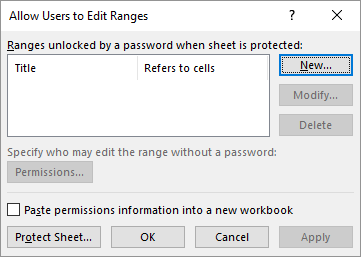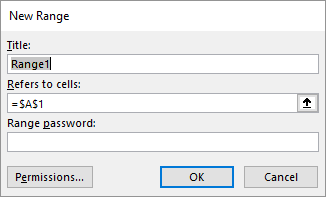Please Note: This article is written for users of the following Microsoft Excel versions: 2007, 2010, 2013, 2016, 2019, 2021, and Excel in Microsoft 365. If you are using an earlier version (Excel 2003 or earlier), this tip may not work for you. For a version of this tip written specifically for earlier versions of Excel, click here: Forcing a Worksheet to be Protected Again.
Written by Allen Wyatt (last updated May 7, 2022)
This tip applies to Excel 2007, 2010, 2013, 2016, 2019, 2021, and Excel in Microsoft 365
Barry can lock a worksheet so that only those to whom he gives the password can edit it. If the person enters the password, makes edits, and then saves the workbook containing the worksheet, that worksheet is then unprotected. Barry wonders if there is a way that, when saving the worksheet, Excel can remind the user to once again protect the worksheet using the same password originally used.
There are several ways you can go about solving this problem. If you've assigned a password to a worksheet, then you simply need to make sure that the same password is used to reprotect the worksheet when the workbook is saved. This is easily done by using a macro that can be tied to the BeforeSave event. This macro should be added to the ThisWorkbook object:
Private Sub Workbook_BeforeSave(ByVal SaveAsUI As Boolean, Cancel As Boolean)
Sheets("ABC").Protect ("XYZ")
End Sub
This example assumes that the worksheet you want to protect is named ABC and that the password used to protect the worksheet is XYZ. You'll want to change these values to reflect your actual worksheet and password.
Note that this macro automatically reprotects the worksheet whenever the workbook is saved. Thus, if a user has a long working session with the worksheet and saves the workbook many times during that session, then they will need to unprotect the worksheet quite often. If you prefer, you can create a macro that will ask if the worksheet should be reprotected:
Private Sub Workbook_BeforeSave(ByVal SaveAsUI As Boolean, Cancel As Boolean)
If MsgBox("Reprotect Sheet ABC?", vbYesNoCancel) = vbYes Then
Sheets("ABC").Protect ("XYZ")
End If
End Sub
Of course, this approach means that it is possible that a worksheet would not be protected again, if the user chose to not reprotect it.
Another approach doesn't involve using macros at all, but uses a different way to do your protection. In traditional worksheet protection, you format individual cells as unlocked, then you apply protection to the worksheet so that any locked cells cannot be changed. If you don't mark any cells as unlocked (which seems to be what Barry is doing), then nothing in the worksheet can be changed without the password.
Excel actually allows you to protect individual ranges of cells within a worksheet. Follow these steps:

Figure 1. The Allow Users to Edit Ranges dialog box.

Figure 2. The New Range dialog box.
There is only one thing you need to remember when you protect your worksheet (step 10). Since you've not unlocked any cells, then all cells in the worksheet will be protected. You need to make sure that the protection you apply allows locked cells to be selected. If, after the worksheet is protected, a user tries to edit a cell that is in the range you specified in step 5, they are asked for the password you specified in step 6. When they provide it, they can make edits to any cells in the range.
The cool thing about this approach is that worksheet protection is not removed—the worksheet is still protected because the user never removed that protection. Thus, the user never needs to know the password for the entire worksheet. When the user closes and reopens the workbook, the worksheet is still protected, just as you need. Plus, you don't have the unavoidable downside of macros—that they can be disabled by a user when they open the workbook.
Note:
ExcelTips is your source for cost-effective Microsoft Excel training. This tip (11973) applies to Microsoft Excel 2007, 2010, 2013, 2016, 2019, 2021, and Excel in Microsoft 365. You can find a version of this tip for the older menu interface of Excel here: Forcing a Worksheet to be Protected Again.

Solve Real Business Problems Master business modeling and analysis techniques with Excel and transform data into bottom-line results. This hands-on, scenario-focused guide shows you how to use the latest Excel tools to integrate data from multiple tables. Check out Microsoft Excel Data Analysis and Business Modeling today!
If you receive a protected worksheet that you want to edit, how do you proceed if you try to unprotect the worksheet and ...
Discover MoreWhen you share a protected workbook with other people, you may not want them to get around the protection by creating a ...
Discover MoreWant to protect a worksheet but maintain the ability to make changes to the check boxes you add to the worksheet? Here is ...
Discover MoreFREE SERVICE: Get tips like this every week in ExcelTips, a free productivity newsletter. Enter your address and click "Subscribe."
2022-05-08 02:38:59
Steve
Allan,
Is there a “before close’ alternative to “before save’ which gets around the issue of in session saving?
Steve
2022-05-07 07:40:09
Philip
Why not put this macro in a "BeforeClose" event of the workbook? that way, the user can save as many times they want during a long session, but the protection will only be re-activated when really "closing" the workbook ...
2022-05-07 05:43:45
Keebellah
And why not include the parameter UserInterfaceOnly:=True?
Got a version of Excel that uses the ribbon interface (Excel 2007 or later)? This site is for you! If you use an earlier version of Excel, visit our ExcelTips site focusing on the menu interface.
FREE SERVICE: Get tips like this every week in ExcelTips, a free productivity newsletter. Enter your address and click "Subscribe."
Copyright © 2025 Sharon Parq Associates, Inc.
Comments